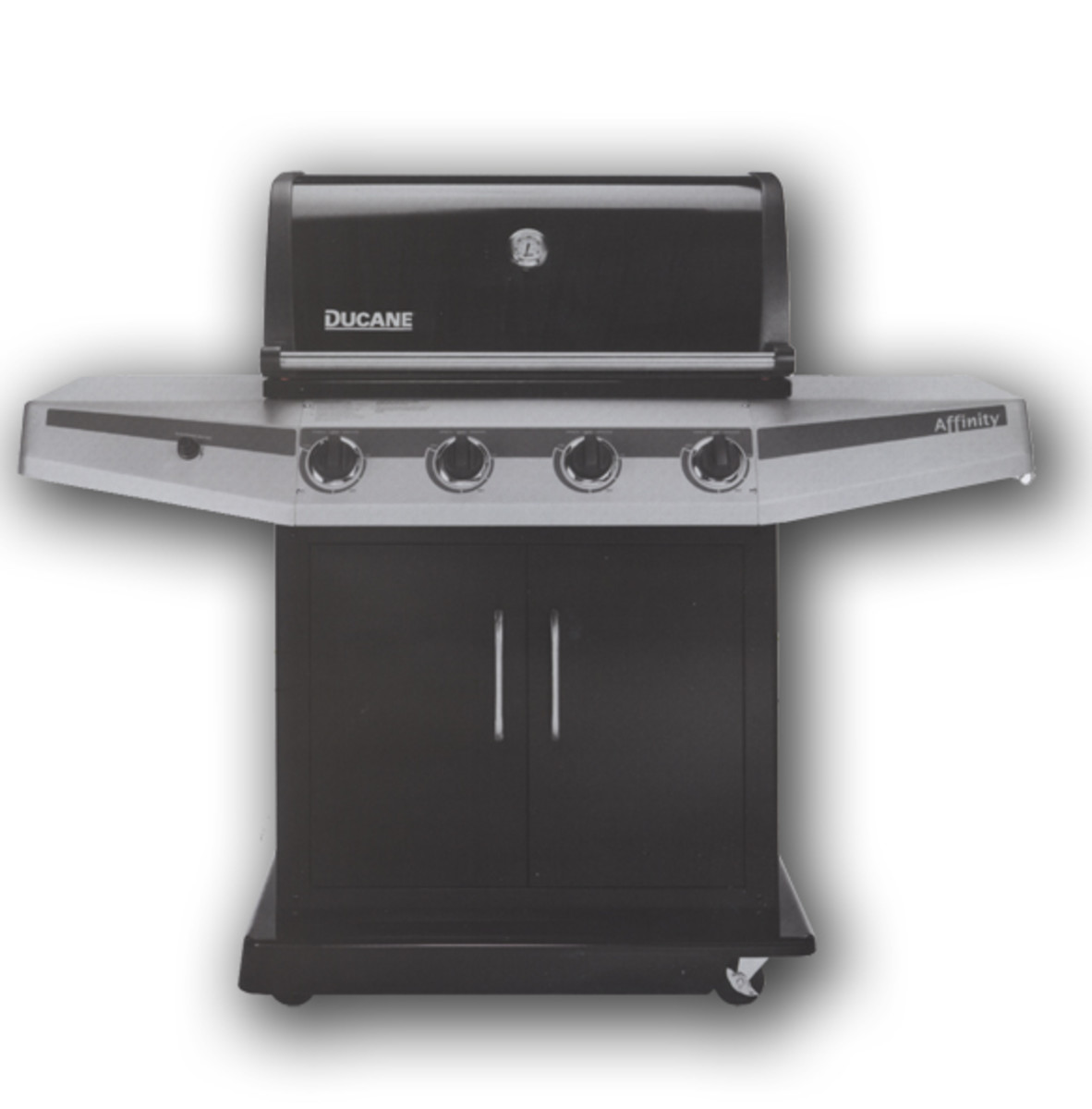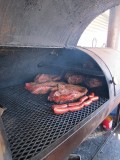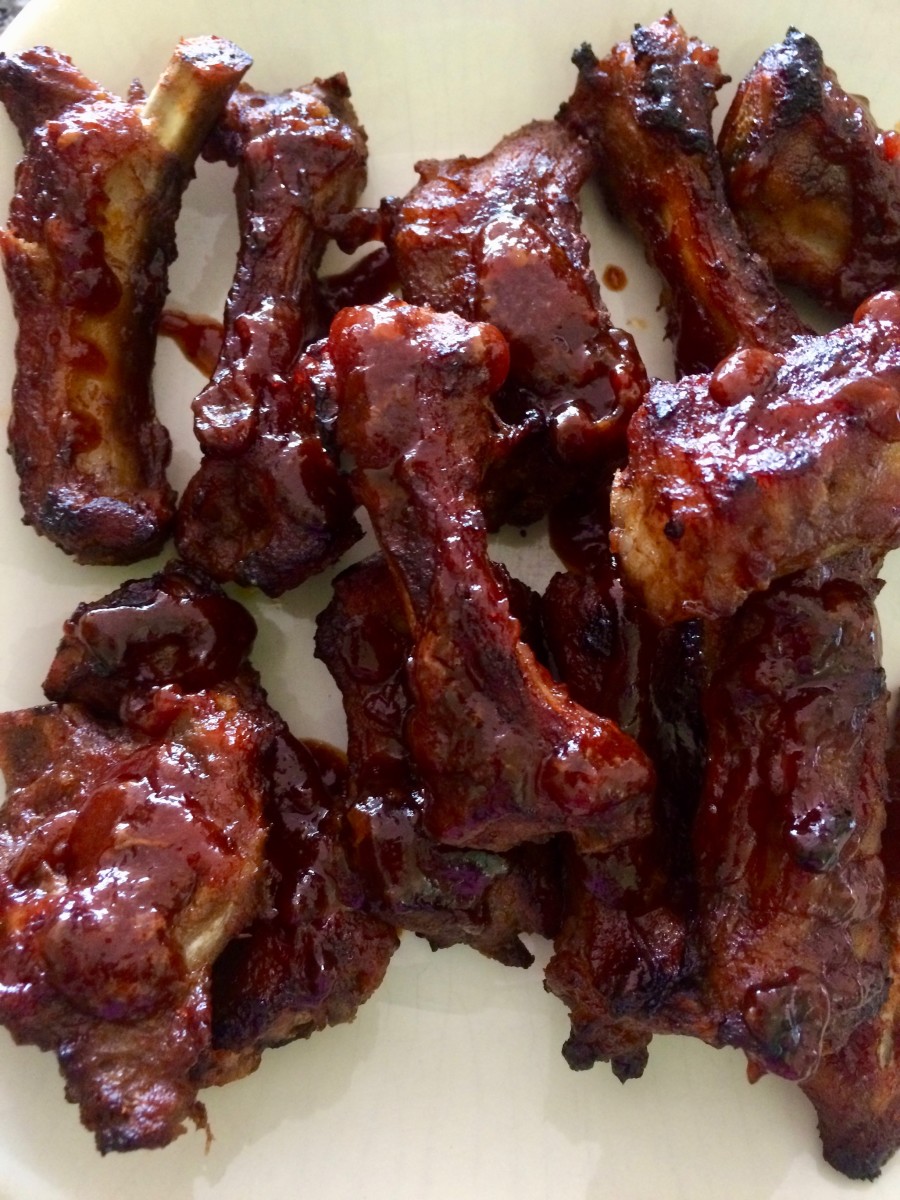Barbecue and Grillips Tips
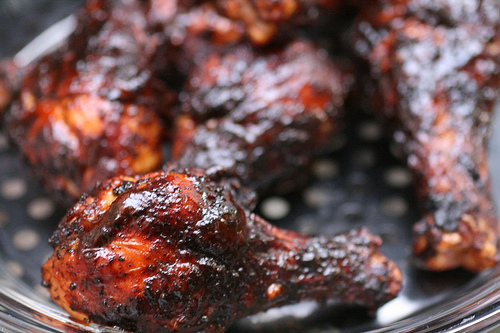
Grilled Chicken with Alabama White Sauce
Sometime in the 1500's a group of Spaniards showed up on the shores of South Carolina with a whole passel of pigs. They were met by a group of Native Americans, who apparently had a bag of briquettes in their pockets. They may not have known it at the time, but the patron saints of the culinary world were watching - because Southern Barbecue was born at that moment. The Heavens shone, angels sang and we've all been blessed every since.
Not long after that however, some heretic popped up and called it grilling - and the Great Schism began. People got polarized, most ended up confused, and in the end, nobody really knew what was what. It's ok - think of this as the New Barbecue Catechism. I'll sort you out - and you'll see it's all really a problem of semantics. (How about that as a triple metaphor?)
So let's talk definitions, methods, techniques - and {*gasp* - dare I say it?} - interreligious relations. Here we go...
BBQ Baby Back Ribs
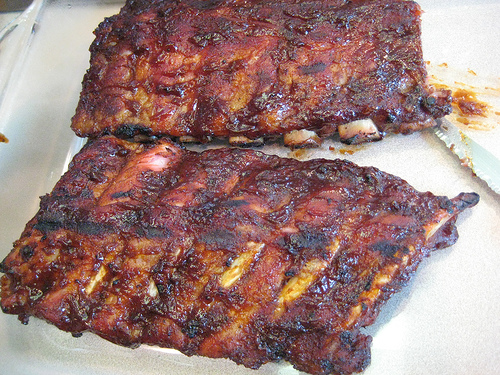
Barbecue might mean...
Might have derived from the Taino in the West Indies, from their barbabicu" , meaning "sacred fire pit". I like that - it matches my metaphor.
Might have derived from the French barbe-a-queue , meaning from "snout to tail"
Might have come from the Spanish derivation of an Amerind word barbacoa , a method of roasting
Linquists will tell you that babies typically utter ''ba-ba-ba' as their first syllables when learning to speak. I think they're trying to say 'barbecue', and when they realize they have no teeth to chew it with, they cry.
So what's the problem?
None. Really. You cook something over open flame and it'll taste good. The issues people seem to have come into play over wording. Someone invites you over to barbecue, and they do nothing but throw shrimp on the grill for ten minutes. So where was the barbecue? There wasn't one!
Barbecue is the main culprit - the word that is. It can be used not only for a method of cooking, it can be used to describe the apparatus on which food is cooked, and it can be used for a party with lots of pig and beer. It's a verb and adjective and a noun and they aren't necessarily deriviatives of the same root. The original word is even disputed. No one seems to know who brought it over or what it might have meant. The only concensus is that it meant to cook over a slow fire.
So if you're going to barbecue you're going to slow cook something. It's that simple. If you grill, you cook something quickly. So - barbecue means low and slow, grilling means hot and fast. That part is pretty clear - what can mess you up is the introduction of the apparatus, because you can grill on a barbecue and barbecue on a grill. The two words are used interchangeably to mean the big metal thing on your patio that holds the fire. Just remember that we're talking technique here - so low and slow heat is what we want for barbecue, no matter how you apply it. We grill quickly. That's it. We good so far?
The child has obviously discovered his first barbecue.
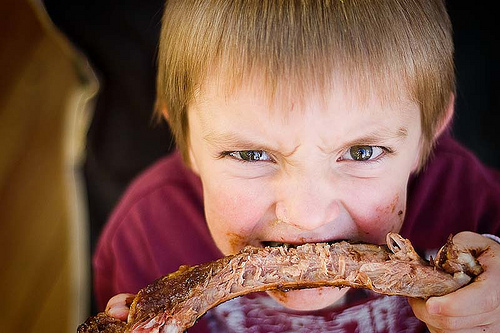
NC Style Barbecue Burger
Grilled Coconut Shrimp with Mock Thom Ka Shooters
Beer Can Chicken, Part 1
Beer Can Chicken, Part 2
Grilled Chicken
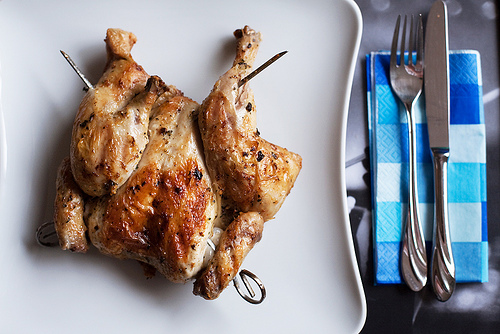
Methods and Techniques
Now we know we have two directions here, let's look at them both.
Barbecue
Historical usages aside, in modern Southern English (as opposed to British English or US English) the word barbecue means to cook over low heat over a period of time that can stretch up to 24 hours. Lots of things are fair game to hit this method, including beef, pork, chicken and lamb or mutton. Different parts of the South favor different cuts - pork rules in Tennessee, Alabama and Western North Carolina. Beef is first choice in Texas, Maryland and parts of Kentucky. Mutton you'll find in Kentucky, and all of us love chicken. In the case of any protein however, low slow heat tends to favor 'poor' quality cuts - cuts that are high in flavor, but also high in connective tissues that can make it tough.
Low heat helps break down the collagen present in brisket, ribs, and shoulders. The collagen melts, the fat in the meats render and the result is pure succulence. In addition to that, often (but not always) barbecuing involves the smoke of various aromatic hardwoods - apple, pear, hickory, oak - and the slow smoking of the meats means that the proteins picks up those intense, rich flavors as well. So when you find yourself facing a plate of beef brisket that's been slow smoked, you have juicy, tender, luscious and smoky . And that right there, children, is why Southerners get fanatical about their barbecue. Can I get an Amen?!
If you want to successfully barbecue almost anything, remember that you'll need to control the heat. That's your first - and really only rule. I never let anything I'm barbecuing pass 225F, and usually keep the temperature inside my barbecue or smoker at 200F. Depending on the meat - cut and size - that I'm barbecuing, the time I let the meat go on the heat can go from three to twelve hours. That sounds excessive, but think about this. You want to slowly increase the internal temperature of the meat to a level that's safe to eat. On top of that, you need enough low heat to slowly melt the collagen and tenderize connective tissues. With the heat as low as 200F - that takes a while.
Grilling is what most people do when they talk about either grilling or barbecuing. If you take a look at the videos I've posted, you'll maybe see why. It's a lot quicker, and can be much easier. It's not always possible to baby a grill or smoker over the hours it takes to produce true barbecued meats, but just about anybody can take a half hour and knock out some burgers. I do barbecue fairly regularly, and realized myself it tends to be on lazy kick-around days when I can putter with the smoker every once in a while. When I shoot the videos, I like to go straight through them - planning the dish, video and shoot and knocking them all out. To make a barbecue video I'd have to be camera ready for hours. Yikes. A twelve hour cook time doesn't translate easily to a ten minute video. My lipstick won't last that long.
Grilling, remember, is cooking over a hot fire - not a low one. Gas or charcoal is a matter of personal preference - what really determines success on the grill is control of the heat. I use a gas grill because it's quick and convenient, but I have a charcoal grill as well and use it with some regularity. Especially holidays when I have both grills AND the smoker fired up...
Lots of cuts work well with grilling, especially leaner, higher quality meats. Chicken is more often grilled than barbecued, and steaks were made for the hot, high sear that a grill can give them. Rack of lamb, fat bone-in pork chops, burgers of all makes and models - and seafood! The lean nature of most seafood makes it a poor candidate for barbecuing (I said most, not all!), but seafood and the grill are a match made in Heaven.
The number one trick you can give yourself when grilling is to have an extremely hot grill. Crank it up. Get it rockin' hot before you start to cook on it. You control temperatuere after you put the food on by two means. One is to control placement of the food over the open flame, and the second is to control the radiant heat by keeping the grill covered or not as you need to. Most grills have air vents as well that will allow you some control over the height of the flame. You may want to start a cut over very high heat, or even some flame (such as a rib eye), then move it to a cooler part of the grill (chicken breast). Or you may want an even medium hot spot with no flame for the entire cooking time (beef burgers). Flame or no flame depends on what you're cooking, and the level of heat will depend on how thick a cut you have. A fat burger, bone in chicken breast or pork chop will take a while, so will need less flame and more indirect heat. Shrimp, many cuts of fish and most vegetables can take higher heat or flame, but need only a few minutes or you'll have char. And I don't mean Arctic Char.
Some beautiful rubs...
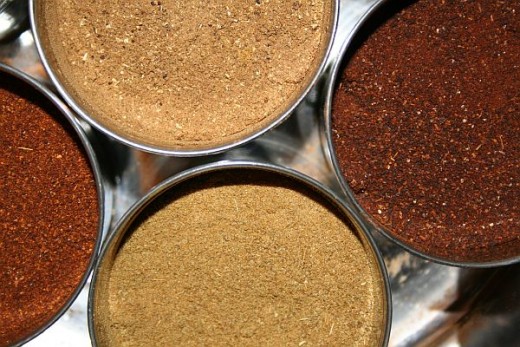
Grilled Vegetables with Lemon
Somebody's smoking something here!
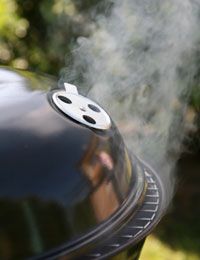
Beyond basic technique...
Ok - we've got our basic techniques down. Let expand...and talk rubs, smokes, mops and sauces.
If you want recipes for barbecue rubs, they're all over the place. That's not what we're doing here, and I'm not about to step into the regional arguments over sauces. This article is about technique and method - so I'm neatly and conveniently side-stepping that particular controversy with relief.
Rubs can be used either for barbecue or grilling. They are nothing more than a mixture of spices and dried herbs that are rubbed into the surface of the meat before it's cooked. Rubs can be made up of almost anything, although salt and pepper are a good base with which to start. You'll often see components in varying proportion such as garlic and onion powders, cumin, oregano, paprika, chili powders of different kinds, and any other flavoring that can stand up to long cooking times. Fresh herbs are a poor candidate for inclusion in a rub; they can't handle the heat and will turn bitter or just plain burn.
When applied to something like a pork shoulder or racks of ribs, to a whole chicken or salmon fillet, often the rub is allowed to sit on the meat for a period of time, much in the way a marinade does. A rub doesn't necessarily serve the additional purpose of tenderizing as a marinade is supposed to, but it can and usually does impart great flavor. Rubs are fair game for any type of cooking - you can barbecue or grill with them, or you can leave them off entirely. Many times with barbecuing, the only rub a die-hard Southern traditionalist will use is salt. And it's delicious. It's all in what you're after at the end.
Smokes
Smoke - for meats - means two things. It means the type of woodsmoke that is used to impart a particular flavor, and it also means a method distinct (but often in tandem with) from barbecuing and grilling.
Different hardwoods have different flavors, and once again, it's a matter of preference. Most cooks will use whichever type of hardwood to which they have access. I freely admit to punting and buying the little bags of commercially produced chips from the local hardware store - in my neck of the woods it's usually hickory, and sometimes apple. Both are good general choices and produce good smokey flavor. I've also been known to get my own chips though too - I'm lucky enough to have access to good aged oak, cherry and walnut. Many barbecuers swear by one type of wood over another - and they do have different flavors, from delicate, sweat pear to earthy, pungent mesquite. Plum, alder, pecan, even grape vines can all be used.
The smoking is also an additional technique. Once you've selected the type of hardwood, you use it to either impart flavor as a meat cooks, as is done in barbecuing, or to cold smoke foods without cooking them, as in the production of bacon, which is then cooked further by another method. For barbecuing this may mean using a wood fire made up of the smoke type you're selected, or by using an electric or propane smoker with a pan containing soaked wood chips. You can also barbecue with smoke on a grill by keeping the heat low and using a pan of chips. It's easy to see how the terms can get confusing - but they are all distinct.
Similarly, if you want the quick high heat of grilling and the added flavor of a particular wood smoke, simply soak your wood chips and add them in a metal pie plate while the grill lid is closed. The chips will smoke and the smoke gets trapped inside the grill, imparting it's flavor to the food. So smoking can be a flavoring method on it's own, or an addition to either barbecue or grilling.
Big Difference. BIG, BIG Difference...
Blackened - in the kitchen, is brilliant when done correctly. It's a technique developed in the 1970's by Chef Paul Prudhomme down in Louisiana, and quickly become beloved worldwide because it was sheer genius.
Burnt is screwed up. Not the same.
Blackened is not burned- something correctly blackened is actually an intensely deep dark red - although it will look black in some light. It's from the cooking of the particular blend of spices and peppers that create the signature blackened flavor over the high heat of a grill or cast iron pan. There's nothing about it that tastes burned .
Burned is bad. Blackened is Bombshell.
Moppin' Up
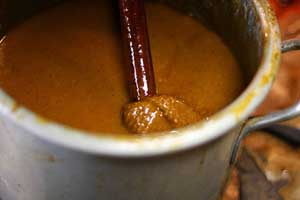
Saucy...
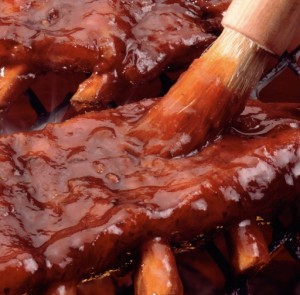
The terms mops and sauces are often used interchangeably - but they are actually two distinct, if wet, items. These will baptize your barbecue. (Yeah, I groaned myself at that one).
Mops are flavored liquids that are applied to foods while they are being cooked, and as a necessity usually have a low sugar content. Traditionally they were applied with a little baby mop - hence the name. Conversely they usually are highly acidic. They're used to impart flavor during the cooking process in addition to or in place of any given by rubs. Because anything containing sugars will burn during a long cook time, mops go without. In return they usually carry the sharp, distinct flavors of acids. Vinegars, especially apple cider vinegar, beer, bourbon, citrus juices, as well as low sugar juices of fruits show up with fair regularity in mops. My personal favorite - a spritzer bottle full of a mix of apple juice and apple cider vinegar.
Sauces, on the other hand, are what most people think of even when they mean mops. Sauces are applied at the end of cooking - since most have at least some sugar content that turns black and burns with cooking. They're also served at table as a condiment. That differentiates them from mops as well - you wouldn't want to douse your sandwich with bourbon. Usually. I'm not going to argue one sauce over another - I have my preferences. But I've also had barbecue all over the South and think each and every one has it's merits. But I will tell you how to do it right if you're going to use them.
Sauces go on at the end of the cooking time. Period.
There's a huge difference in caramelization and burnt. You want the first. That's when the sugars in the sauces have caramelized, creating that gorgeous, crispy, sticky crust that good barbecue or grilled food has. Mops will tenderize and impart flavor as well as keeping food moist, but won't caramelize because the sugar content is too low. You can use sauces correctly with either - the trick is when to apply it. That will vary - if you sauce ribs you've barbecued at 200F, then perhaps 1/2 hour before you pull them off the heat will serve to caramelize the crust without burning them. You may even be able to sauce an hour before you pull them off, as long as you turn them to caramelize both sides. If you're saucing chicken on the grill however, you may have no more than five minutes before beautiful becomes burnt. The best rule of thumb - don't do it until the meat is almost cooked through. That gives you a window to apply and cook on the sauce without overcooking the meat.
Further - rubs can and do contain sugar. Sometimes unbelievable amounts of brown sugar. It's ok - it's all about the interaction of sugar and heat. Just like sauces - rubs with sugar have to be carefully monitored so that caramelization doesn't become charred. There can be a fine line - but worth exploring.
The Great Convergence
Heretical notions aside - I will get all fanatical on you with terms, but when it comes to technique, every one is valid. Even more - I mix them all up. A perfect example is the pulled pork I make - a pork shoulder gets rubbed, then it goes on a very low grill, and I make sure there is plenty of smoke. During cooking it gets mopped, and once it's done it gets sauced. At other times I'll do other dishes - my Alabama White is a mixture of mopped chicken (the buttermilk soak I show), an end sauce and grilling over high heat.
At other times I use the grill to braise - as in the Beer Can Chicken, or to sear (grill) first, then barbecue slowly, especially with some types of ribs. Don't get stuck with barbecue people who get all het up (that's Southern for getting mad) over a 'right' way to do something. Those are the people that probably burned my ancestors at the stake. There may be a right way to make a particular dish, but nobody better dare try to tell me I can't do anything I want once I have the techniques at my disposal. If they try, they don't get to eat.
Don't go down that road - nobody likes a fanatic - learn the definitions and methods. You have the means then to do whatever you wish. If you have your Catechism is in order you can confuse the fanatics by explaining the difference in being burnt at the stake and smoked. (Insert gratuitous blackening methaphor here.)
Visit the Website!
- The Thrillbilly Gourmet
Eat real food! Applying classic technique to everyday food for spectacular results!


